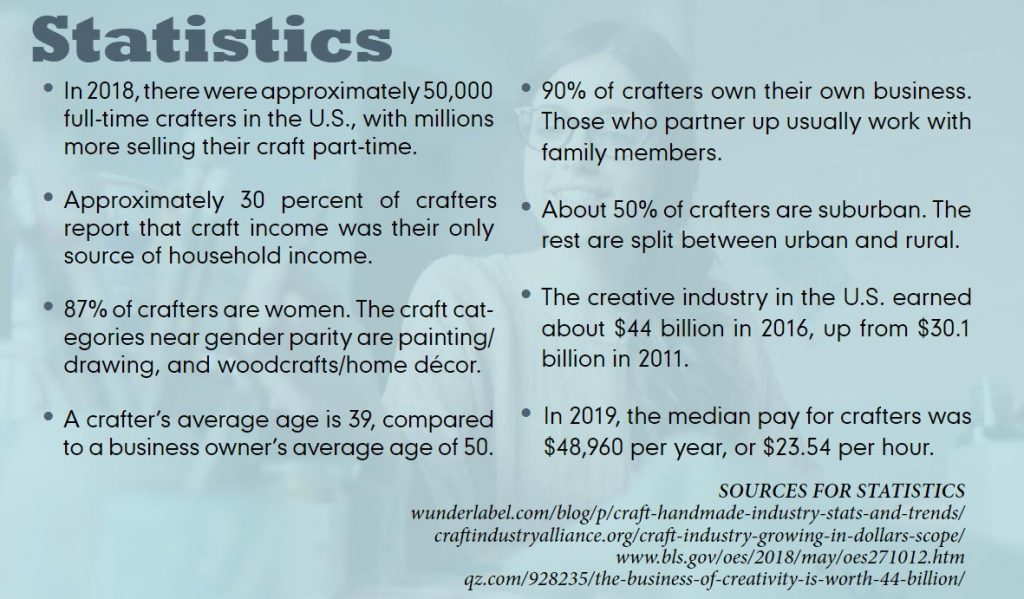By Patrice Lewis
If you’re tired of commuting to an office job and dealing with a boss, it’s worth examining whether or not you can do something extraordinary: make a living and support your family solely by the efforts of a home craft business. It sounds like a fantasy — but can it become a reality? Yes and no.
There are around 115,000 craftspeople in the U.S. (numbers vary from 106,000 to 126,000), and 22 percent of them are entirely
supported by their craft business. Yes, that fantasy can become a reality.
How can you tell if your particular craft will support a family? Keep in mind not all crafts are suitable for turning into a successful business. But these dreams of supporting a family from your hobby are frequently laced with a heavy dose of unrealistic expectations about the craft’s money-making potential. Here are some criteria to determine if your craft can support you.

Find a niche
Finding your unique niche will probably be the single most enormous hurdle to overcome. Can you find that empty niche and create a product to fill it?
The reason this is so difficult is people often focus on making crafts they themselves like, without considering either (a) what the competition is for that particular craft, or (b) how many others share that interest. Sometimes a person becomes so enamored of his or her own particular product that they either won’t do the necessary market research to determine if their product is sell-able, or they ignore what their market research tells them.

How fast are you?
No matter how unique or how large your niche is, it won’t do you any good unless you can make your craft fast enough to meet demand.
If you can only make one of your craft items per week, you won’t be able to support your family with your craft. The secret is to be able to make your craft rapidly enough that you can sell them for a moderate price.
The products most likely to be able to support your family can be made quickly and efficiently without a loss of quality. If your craft lends itself to assembly-line manufacturing, you stand a much better chance of succeeding.
Wholesale versus retail
Where do you sell your products? Do you go to shows and sell them yourself? Do you place them in stores? Do you sell them online? The issue of how to market your product will come down to determining if your craft business will be wholesale or retail.
A retail business means that you, yourself, are selling the item. You go to the craft shows. You open the storefront. You start the Web page. You, you, you.
The trouble with this, of course, is that while you are selling your item, you are not making any new items. The time it takes to sell your product is time away from the production of new product.
Switching from retail to wholesale may be the key. By selling wholesale, the vendor doesn’t have to worry about the time and expense associated with making the craft, and the crafter doesn’t have to worry about the time and expense of being away from home. It’s a win-win situation.
Statistics have demonstrated that, while most crafters still prefer retail shows, more revenue is generated from wholesale markets. Wholesaling accounts for 27 percent of annual sales for crafters.
So if your craft product lends itself to assembly line production, it behooves you to consider developing the wholesale side of your business. You stand a much higher chance of succeeding in a home-based business if you can stay home.
A new hat
It hardly bears repeating that we’re facing some tougher economic times. It’s a smart idea to diversify your income sources by wearing several different hats. With smart marketing, your craft product can become quite a big “hat.”
Patrice Lewis is a wife, mother, homesteader, homeschooler, author, blogger, columnist, and speaker. An advocate of simple living and self-sufficiency, she has practiced and written about self-reliance and preparedness for almost 30 years. She is experienced in homestead animal husbandry and small-scale dairy production, food preservation and canning, country relocation, home-based businesses, homeschooling, personal money management, and food self-sufficiency. She and her husband have been married since 1990 and have two daughters.






